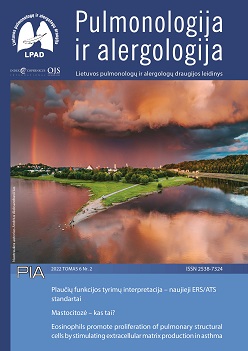Eosinophils promote proliferation of pulmonary structural cells by stimulating extracellular matrix production in asthma
Abstract
Introduction. Eosinophilic asthma can be characterized by intense infiltration of eosinophils into the airways, where they abundantly release various cytokines, chemokines and growth factors. Airway remodeling is closely related to increased airway smooth muscle (ASM) mass; however, another important feature could be changes in extracellular matrix (ECM) homeostasis, driven by the production of ECM proteins and metalloproteinases by lung structural cells. Aim. To evaluate and compare eosinophil adhesion to ASM cells and pulmonary fibroblasts or their secreted ECM and the effect on pulmonary structural cell autocrine proliferation adjustment in asthma. Methods. A total of 12 allergic asthma (AA), 8 severe eosinophilic asthma (SEA) patients and 11 healthy subjects (HS) were examined. Blood eosinophils were isolated using high density Ficoll centrifugation and magnetic separation. For each study individual combined cell cultures (co-cultures) between isolated eosinophils and pulmonary structural cells or their secreted ECM were prepared. ECM purification was performed using ammonium hydroxide (NH4OH) based cell lysis. Eosinophils adhesion was evaluated by measuring eosinophils peroxidase activity in co-cultures; pulmonary structural cell proliferation was measured by AlamarBlue assay. Results. In all investigated groups eosinophil adhesion to ECM was significantly increased compared to eosinophil adhesion to ASM cells and pulmonary fibroblasts (p < 0.01). Eosinophil adhesion to ASM cells and pulmonary fibroblasts or their secreted ECM in asthma groups was significantly enhanced compared to HS group (p < 0.05). Isolated ASM cell or pulmonary fibroblast’ produced ECM after co-cultures with AA, SEA and HS eosinophils promoted newly seeded ASM cell and pulmonary fibroblast proliferation (p < 0.01) with stronger effect in both asthma groups. ECM, isolated after combined cultures with AA, SEA or HS eosinophils and the blood serum of the study patient also significantly promoted the proliferation of ASM cells and pulmonary fibroblasts (p < 0.01). Isolated ASM cell or pulmonary fibroblast’ produced ECM after co-cultures with AA and SEA eosinophils had a stronger effect to newly seeded pulmonary structural cell proliferation than after co-cultures with HS eosinophils. Conclusions. Eosinophils demonstrate enhanced adhesion to ECM components than to ASM cells or pulmonary fibroblasts, and adhesion further increases in asthma. Pulmonary structural cells promote their proliferation in autocrine manner via released ECM components after incubation with eosinophils in asthma.


